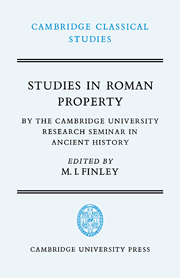Book contents
- Frontmatter
- Contents
- Preface
- 1 INTRODUCTION
- 2 SOME CONFIGURATIONS OF LANDHOLDING IN THE ROMAN EMPIRE
- 3 IMPERIAL ESTATES
- 4 CLASSICAL ROMAN LAW AND THE SALE OF LAND
- 5 THE CICERONIAN ARISTOCRACY AND ITS PROPERTIES
- 6 PRIVATE FARM TENANCY IN ITALY BEFORE DIOCLETIAN
- 7 URBAN PROPERTY INVESTMENT
- 8 AGRI DESERTI
- Notes
- Bibliography
- Index
3 - IMPERIAL ESTATES
Published online by Cambridge University Press: 05 June 2014
- Frontmatter
- Contents
- Preface
- 1 INTRODUCTION
- 2 SOME CONFIGURATIONS OF LANDHOLDING IN THE ROMAN EMPIRE
- 3 IMPERIAL ESTATES
- 4 CLASSICAL ROMAN LAW AND THE SALE OF LAND
- 5 THE CICERONIAN ARISTOCRACY AND ITS PROPERTIES
- 6 PRIVATE FARM TENANCY IN ITALY BEFORE DIOCLETIAN
- 7 URBAN PROPERTY INVESTMENT
- 8 AGRI DESERTI
- Notes
- Bibliography
- Index
Summary
When in A.D. 193 Pertinax was appointed emperor as a senatorial candidate, he faced the problem presented to each new Roman dynasty of what attitude should be taken to its predecessor's personal possessions. Of these land was one of the most important. Pertinax' reaction, if we may believe Herodian (2.4.1–7), was both novel and positive. His own name was not to be given to imperial possessions which belonged rather to the whole Roman people and, in an attempt to bring uncultivated areas of the empire back into production, he proposed to offer ten years' tax remission to those who would undertake their cultivation, to be followed by outright possession of the land, including that which was previously imperial.
Few emperors shared the scruples of Pertinax and the passage is controversial (see chapter 8); but the proposals of Pertinax may be used to illustrate the issues with which I shall be concerned in this paper: firstly, the definition of imperial estates; secondly, their movement in and out of imperial control; thirdly, their management, both separately within the estates and more generally on a provincial level within the overall economy of the empire; and finally, the involvement of the emperors with their estates. The main limitation will be that imposed by the evidence, which inevitably gives an incomplete and somewhat erratic coverage by both period and province. It is nonetheless important to concentrate on those estates actually attested as imperial and to exclude land merely thought to be imperial. I have attempted to collect the chief sources for attested imperial estates in the Appendix but such a list inevitably remains provisional.
- Type
- Chapter
- Information
- Studies in Roman PropertyBy the Cambridge University Research Seminar in Ancient History, pp. 35 - 70Publisher: Cambridge University PressPrint publication year: 1976
- 25
- Cited by

